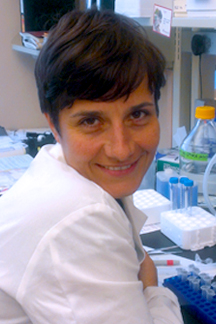Team Identifies Potential New Drug for Inherited Cancer
By Eric Sauter
Scientists from the Florida campus of The Scripps Research Institute (TSRI) have identified a new drug candidate for an inherited form of cancer with no known cure.
The new study showed the drug candidate—known as FRAX97—slowed the proliferation and progression of tumor cells in animal models of Neurofibromatosis type 2. This inherited type of cancer, caused by mutations in the anti-tumor gene NF2, leads to tumors of the auditory nerve that connects the inner ear to the brain.
The new compound, originally developed to treat neurodegenerative disease, targets a protein family known as p21-activated kinases or PAKs. These kinases (enzymes that add a phosphate group to other proteins and change their function) play a critical role in the development of Neurofibromatosis type 2. PAK1 has also been implicated in the growth of breast and lung cancers.
“Our study shows that if we inhibit these kinases we can counter the formation of tumors in this brain disease,” said Joseph Kissil, a TSRI associate professor who led the study.
In the new study, published in the October 4, 2013 issue of The Journal of Biological Chemistry, Kissil and his colleagues showed that the inhibitor slows down progression of Neurofibromatosis type 2 in animal models and reduces more than 80 percent of PAK1 activity.
Kissil notes a key challenge in developing drug candidates is finding potential agents that are both potent and highly selective for their targets—limiting its action to the desired arena and reducing unwanted side effects.
“This inhibitor turned out to be both potent and highly selective,” he said. “The real question is why. We were able to show that it works through a unique mechanism.”
While the binding site on PAK1 is quite large, it also contains a smaller pocket, a kind of backroom that juts off the larger site. The inhibitor not only takes up space in the larger site, but enters the back pocket as well. That extra binding gives the inhibitor its strong selectivity.
The first authors of the study, “FRAX597, a Small Molecule Inhibitor of The P21-Activated Kinases, Inhibits Tumorigenesis of NF2-Associated Schwannomas,” (The Journal of Biological Chemistry, Vol. 288, Issue 40, 29105-29114) are Silvia Licciuli and Scott Troutman of TSRI; and Jasna Maksimoska and Chu Zhou of The Wistar Institute (Philadelphia, PA). Other authors include Smitha Kota of TSRI; Qin Liu and Ronen Marmorstein of The Wistar Institute; Sergio Duron and David Campbell of Afraxis, Inc. (San Diego); Jonathan Chernoff of Fox Chase Cancer Center (Philadelphia, PA) and Jeffrey Field of University of Pennsylvania Perlman School of Medicine. For more information on the paper, see: http://www.jbc.org/content/early/2013/08/19/jbc.M113.510933.abstract
The study was supported by the National Institutes of Health (grant numbers CA124495, CA114046 and CA148805); the American Cancer Society (RSG-10-018-01-CDD) and Afraxis, Inc.
Send comments to: press[at]scripps.edu
















